 |
 |
|---|---|
| Zuni waffle garden, circa 1950 | Zuni greenhouse project, 2007 |
ZUNI, NM—Alexandre Jamon, 17, and his science teacher were sitting around one day when Alex started talking about vegetarianism—so he and teacher Alicia Fitzpatrick hopped on the Internet together and bought a copy of Diet for a Small Planet for 79 cents. After reading the book, Alex felt inspired—and then incensed. Lunch at his high school offered no fresh fruits or vegetables, and no vegetarian options. All students at Twin Buttes qualify for free or reduced lunch, so everyone eats at the cafeteria. Alex checked with other students and found that almost everyone felt less than thrilled about what was on their plate at lunchtime. “Traditionally, Zuni food has a special quality,” Alex says. “There are no preservatives in it and it is all done organically”—a far cry from a frozen pizza in a Styrofoam box. Together, the students started voicing concerns about nutrition.
Rather than dwelling on the problem, however, they decided to invent a solution. That spontaneous act launched the student body into an adventure in sustainable agriculture. Five months later, they’ve won grants, demolished an abandoned building, developed their own agriculture management curriculum, designed a plan to combine traditional Zuni waffle gardening with modern greenhouse methods, built a greenhouse, and won a promise that their fresh produce may be sold in the community grocery store—the produce they don’t eat in the school cafeteria, that is.
In this small pueblo of sun-drenched earth and bright blue skies, two hours west of Albuquerque by car, the Zuni Greenhouse Project is transforming Twin Buttes High School and the lives of its students.
Outdoor learning laboratory allows research in action
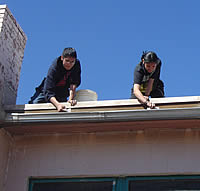 At a far corner of the school, students climb a ladder to investigate the gutters that will funnel rain into a catchment system made of rusty barrels. They plan to harvest rainwater from the school roof, because a drought has plagued the area for several years. Zunis have long practiced water conservation strategies—and the ancient waffle garden pattern in use throughout the area holds moisture near the plants’ roots. The sunken garden is divided into squares that look just like a waffle, with plants where the syrup would pool.
At a far corner of the school, students climb a ladder to investigate the gutters that will funnel rain into a catchment system made of rusty barrels. They plan to harvest rainwater from the school roof, because a drought has plagued the area for several years. Zunis have long practiced water conservation strategies—and the ancient waffle garden pattern in use throughout the area holds moisture near the plants’ roots. The sunken garden is divided into squares that look just like a waffle, with plants where the syrup would pool.
In the center of the yard, the “Alternative to Expulsion” teacher looks on while a group of girls takes turns wielding a heavy sledgehammer, banging steel piling into the gravel foundation. “I like using the level and laying down gravel,” a soft-spoken girl named Farrah says. Two tattooed boys carry the curved pipes that will form the spine of the greenhouse across the dirt, casting long, thin shadows.
“Greenhouse is important to me because we as students built it and got the money to get the Greenhouse,” Justin says. “It is important to me to keep it going and maintain it so other people who go to school there can have a good house and maintain it. It’s nothing I’ve never done before so building it and maintaining it, it’s something exciting.”
| “I believe that a school and a community shouldn’t be separate entities. They are the same. I believe it is the responsibility of the educator to explore and learn about the community, to have the critical conversations necessary to learn what resources are available there to enhance the curriculum that you are using or developing.”—Alicia Fitzpatrick, Educator |
Richelle, 17, says, “The Greenhouse is important to me because many people in the pueblo doubt Twin Buttes High School because it’s an alternative school. They consider it like a drop-out school, and I think we’re making a big change with the community and the school. That’s important.” Alex agrees: “I always hear students say that they’re embarrassed to go to school at Twin Buttes. Now I think people look at it and feel proud.”
The Greenhouse Project has mobilized the school with an energy of purpose that seems unique to action research. Alicia Fitzpatrick watches all the buzzing activity contentedly: This method is her pedagogical passion. “The students are totally designing their entire units. They have complete decision-making and voice. They choose their topics, determine their objectives, and decide how they’re going to study and reach those objectives. I’m just allowing them the space. It’s radical to see what they can do when they are allowed to,” Fitzpatrick says.
In the science classroom, students—unabashedly artistic—design a logo and Website for the project. Younger students are talking about building beds to grow flowers outside of the school’s front door.
The careful work of using a level and a line requires frequent measurement, and a group of students gathers around the paper plans that came with the greenhouse, deciphering its diagrams and shorthand. “It seems we work better in small groups—less than five,” someone says out loud, and other people nod. Mathematics, chemistry, biology, writing, the science of nutrition, bookkeeping, and business basics….it all comes together.
Unlike most other school garden programs, which invite young people into a garden environment, at Twin Buttes the students themselves are creating the garden from the ground up. “It was really surprising when we realized that in order to have a fresh salad bar everyday, we’d need to have a growing area the size of a couple of football fields,” Alex Jamon muses, smiling. “So you know, you have to do your math, and start small.”
School as family: connecting school and community
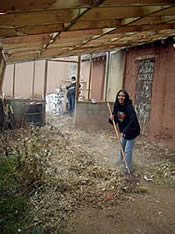 Planting and growing food are not news in Zuni—to the contrary, they are the very basis of the Zuni culture. Agriculture is intertwined with art, religion, language, and all of the stories of the people. Yet since the 1940s, people on the reservation have grown their own food less and less. Slowly but noticeably, livelihoods changed, and a diabetes epidemic began. And so, this Greenhouse Project is about more than food. On a deeper level, the students at Twin Buttes are pioneering in Native America: They’re moving to reclaim their native lifeways and integrate them into the public education system.
Planting and growing food are not news in Zuni—to the contrary, they are the very basis of the Zuni culture. Agriculture is intertwined with art, religion, language, and all of the stories of the people. Yet since the 1940s, people on the reservation have grown their own food less and less. Slowly but noticeably, livelihoods changed, and a diabetes epidemic began. And so, this Greenhouse Project is about more than food. On a deeper level, the students at Twin Buttes are pioneering in Native America: They’re moving to reclaim their native lifeways and integrate them into the public education system.
Twin Buttes students have decided to do traditional ceremonies in their garden and greenhouse. For some students, doing so will honor their ancestors—and protect both the reputation of the project and the health of their harvest, by not angering or saddening those ancestors.
Student Chris Watsa, 18, is happy that his classmates will follow the traditional steps of thanking the earth and sun, offering blessings and prayer. Chris tends a waffle garden with his girlfriend Elaine in her family’s front yard. Elaine, 15, loves taking care of their garden: “Your plant is like your baby. We say to the plants, grow, grow, we want you to grow!” The intimate, caring relationship that Zunis have with plants is often described in terms of parent and child. Chris explains in detail:
“When you first put in a seed, you have to watch it because a dog or something might come along and dig it up and that’s it. You have to wake up in the morning, offer cornmeal to the sun, then water the garden, and in the day as it gets bigger, there are more problems to watch for. There will be weeds around it. There will be things you don’t want in your garden. That’s like watching your child and you don’t want none of the stuff that’s going on in other kids’ minds to get in it. So you take that out, and as it starts getting big, it needs water, it needs loving, so you have to make walls to protect it and let it know that it’s loved. And when it gets big, you watch it grow. As you watch it, you get older, and that’s like you becoming an elder. You see and you look and you see an ear of corn start coming out. You see another one. When it comes out to ripe corn, you know, that’s your child. You know what I mean? You’ve got to take that, cherish it, value it, no matter what, no matter if it came out late or if it came out early, you always have to cherish it.”
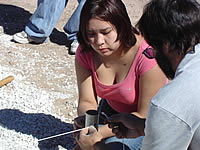 The idea of family in the school garden isn’t just symbolic—several students at Twin Buttes have children already. Taking staff into account, the school has several generations of families under its roof. Health Assistant Noreen Boone’s daughter Adonica and son-in-law Ross attend Twin Buttes High School and are teen parents. Boone spoke on the subject:
The idea of family in the school garden isn’t just symbolic—several students at Twin Buttes have children already. Taking staff into account, the school has several generations of families under its roof. Health Assistant Noreen Boone’s daughter Adonica and son-in-law Ross attend Twin Buttes High School and are teen parents. Boone spoke on the subject:
“My son-in-law, Ross, is participating in that Greenhouse and he’s really into it. Ross was also wondering how to go about buying him a small greenhouse. Kaya, their daughter, was thin, they took her up and she was low on iron. They said, “How can we get the iron to go up?” I said with food like meats, eggs, fresh green vegetables. So he wants to grow at home. It’s helping them eat more like vegetables, too, because they never used to. So it’s helping both in health and parenting.”
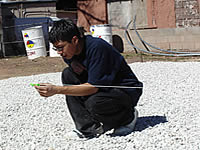 When word about the project got out into the community, elders began saving seeds. A community member called and offered peach trees; another family offered part of their land by a lake for planting. If a harvest comes, Halona Plaza—the store at the center of the Pueblo—will dedicate a special space to selling the students’ crops. The director of the A:Shiwi A:wan Heritage Museum, Jim Enote, is teaching workshops for the students, so that they understand the communal and ritual aspects of Zuni planting.
When word about the project got out into the community, elders began saving seeds. A community member called and offered peach trees; another family offered part of their land by a lake for planting. If a harvest comes, Halona Plaza—the store at the center of the Pueblo—will dedicate a special space to selling the students’ crops. The director of the A:Shiwi A:wan Heritage Museum, Jim Enote, is teaching workshops for the students, so that they understand the communal and ritual aspects of Zuni planting.
Planting faith for the future
A harvest doesn’t come automatically or all at once—and in Zuni, it is taboo to talk of a harvest as if it is a sure thing. “If we are lucky enough to have a harvest,” is how students preface their plans to market herbs and vegetables.
Harvest of food or not, the young people are harvesting an unforgettable educational experience. They’re documenting their learning process with photography, journals, and video, and have been asked to present at three conferences over the course of the summer and next school year.
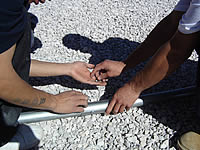 Student Garren Tsethlikai says, “If we’re lucky and blessed with a harvest, how cool would it be to market Greenhouse tours to the tourists at the Arts & Crafts Center? And then on the walls of the adobe house, laminate pictures of the traditional vegetables that we’re going to grow with the Zuni word and the English word?”
Student Garren Tsethlikai says, “If we’re lucky and blessed with a harvest, how cool would it be to market Greenhouse tours to the tourists at the Arts & Crafts Center? And then on the walls of the adobe house, laminate pictures of the traditional vegetables that we’re going to grow with the Zuni word and the English word?”
A worn bilingual poster on the school wall advises, Hon yumola a:ho’ik’yanna: Be honest and trustworthy to one another. Hon i:yansatdena:wa: We will help one another. Don dehwan illaba: It is your turn. Hom dehwah ukna:we: It is my turn.
It is the young people’s turn in Zuni, in more ways than one.




